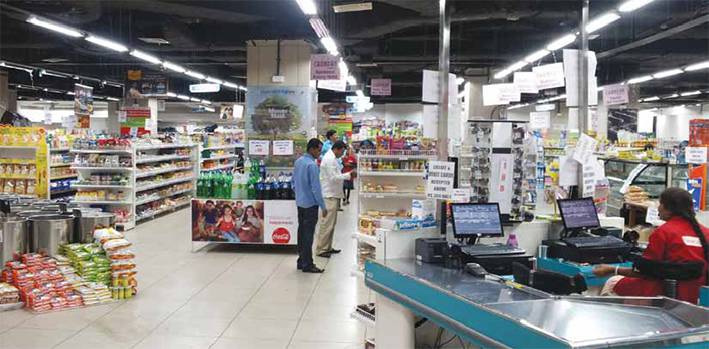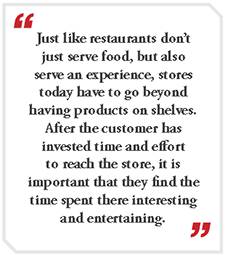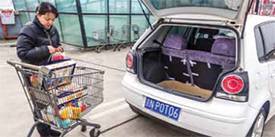The Experience Premium
With online retail eating into the business of brick and mortar retailers, stores need to ramp up facilities and provide an enhanced experience to shoppers to counter the convenience and price advantage of e-commerce
The traffic in Bangalore is getting steadily worse. When work starts on water mains or sewage pipes, even roads that were low traffic become clogged with indisciplined drivers. So, do you really feel up to stepping out to browse in a shop for new clothes? This is the logic on which many e-commerce companies have built their marketing plans. Other than just straight discounting. But what happens to the regular brick and mortar retailer, who finds that customers are finding it too irksome to make the trip to their store, unless there is a pressing need?

There is a distinct difference between purchasing something online and actually seeing and handling the product before buying it. Technology today doesn’t go beyond a simple photograph of a standard branded FMCG product and maybe some close-up shots if you are buying furniture or apparel. The reality and tangibility of the feel of a fabric or the investment in quality packaging is lost. So, while routine purchases are easily transferred to the online world, it is much more difficult to do this with more complex, specialist purchases.
For the retailer, the access challenge is compounded by the fact that the very people who are high spenders are the ones who often value their time the highest. So, if they lack the motivation to drive up to the store, it deprives the retailer of a premium customer. Often these customers are the ones who are the most price insensitive. Instead of getting these premium customers the store will attract people who might generate footfalls but may not make high margin purchases.
Given this reality, what can a retailer do to drive up sales?
Talking to the people
 To help answer this question, a group of young people, with good disposable incomes were called into a room and were posed the question “Have you recently gone to a store?” and “What made you go?”. The responses were interesting.
To help answer this question, a group of young people, with good disposable incomes were called into a room and were posed the question “Have you recently gone to a store?” and “What made you go?”. The responses were interesting.
The first off the bat was location. This was no surprise. “The store was on the way and so it was easy for me to stop there”. This reinforces the old truism that in retail the three most important factors are location and location After that, other points that were raised were “trust”, “I like to go out”, “I want to see and feel the product”, “it’s only available there” and “I can take it home with me immediately”.
While online purchases are about convenience, there are many other levers that a retailer can make use of to drive sales. Interestingly, no one mentioned “discounts” or “offers”. Given the current investment climate in e-commerce, it is unlikely that brick and mortar companies can compete by giving price off. Moreover, the clientele that the store would like to attract tend to value time and experience more than pricing.
What a retailer can do
So, if a store were to look at generating a competitive position, there are some key dimensions on which it would need to focus. These are differentiators that can help pull people into stores. Many of these are known but not all are executed with the kind of focus that is needed to make it really work.
Location and convenience
This will always come out on top, but now requires more. Is there easy access to parking? Is it easy to locate what I have come in search of? How quickly can I finish billing and payment? Is the store capable of handling sudden crowds at the billing counter without making me wait in long queues? Or, do I need to schedule my visit to the store only at those times when the crowd is less? Is it easy to get out and leave?
Experience and ambience
 Just like restaurants don’t just serve food, but also serve an experience, stores today have to go beyond having products on shelves. After the customer has invested time and effort to reach the store, it is important that they find the time spent there interesting and entertaining. This entertainment need not be a music show that will end up completely diverting me from my shopping. Instead it could be around product demonstrations, “how to” programmes, videos and displays. Get people to experiment and try out new things they would never type into the Search box of an online site.
Just like restaurants don’t just serve food, but also serve an experience, stores today have to go beyond having products on shelves. After the customer has invested time and effort to reach the store, it is important that they find the time spent there interesting and entertaining. This entertainment need not be a music show that will end up completely diverting me from my shopping. Instead it could be around product demonstrations, “how to” programmes, videos and displays. Get people to experiment and try out new things they would never type into the Search box of an online site.
Customisation and alteration
Today every clothing store offers quick service tailoring to adjust the length of a pant. Grocery stores allow you to buy one apple or exactly the amount of paneer that you want. What else can be done to customise products to the needs of customers? The more that can be done, the more likely the customer would want to come back to meet their special needs.
Advice and guidance
People are trying out new products and huge numbers of new products are being introduced into the market both from domestic suppliers and through imports. At the same time, many consumers are exploring and upgrading in their purchase decisions. Naturally, a lot of people are unsure of what the products are for and how they should be used. Getting good advice and being guided in the purchase decision is still best done one on one.
While these are differentiators and the hooks to pull in people into stores, it is obvious that the basic requirements need to be met. So, the product must be on the shelf, it needs to be tagged and priced accurately, layouts and displays must be evocative and functional, hygienic, etc. A sloppy store will irritate a premium customer and it is probable that nothing will get them back in.
Looking into the differentiators again, it is clear that making them work is dependent on one really critical factor - the people who staff these stores. The level of professionalism, training and integrity they demonstrate will decide whether customers want to come back. Unfortunately, many stores still have “sales” people, who view the customer as a target to meet a sales incentive. The attitude that having more sales people means more sales is also incorrect. The quality of the people can make a huge difference, both in terms of sales productivity and customer engagement. This is vital if stores want high-value customers to continue walking in through the door and picking items off the shelf. As long as that is happening and the experience is engaging, people will continue to pull out their wallets. On the other hand, if the environment is transactional, the customer may as well interact with a screen.
The author is Partner & Managing Director – Indian Operations, CGN & Associates India Pvt Ltd




.png?width=203&name=CGN_Tagline1%20(1).png)